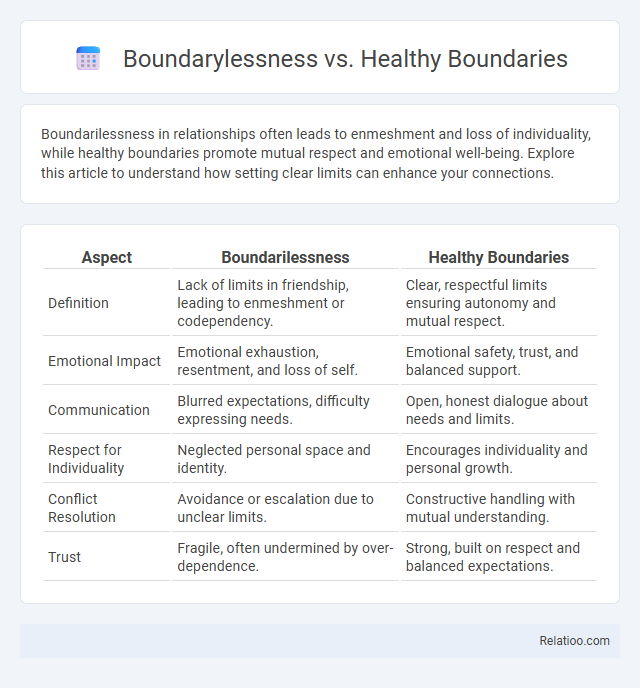Boundarilessness in relationships often leads to enmeshment and loss of individuality, while healthy boundaries promote mutual respect and emotional well-being. Explore this article to understand how setting clear limits can enhance your connections.
Table of Comparison
| Aspect | Boundarilessness | Healthy Boundaries |
|---|---|---|
| Definition | Lack of limits in friendship, leading to enmeshment or codependency. | Clear, respectful limits ensuring autonomy and mutual respect. |
| Emotional Impact | Emotional exhaustion, resentment, and loss of self. | Emotional safety, trust, and balanced support. |
| Communication | Blurred expectations, difficulty expressing needs. | Open, honest dialogue about needs and limits. |
| Respect for Individuality | Neglected personal space and identity. | Encourages individuality and personal growth. |
| Conflict Resolution | Avoidance or escalation due to unclear limits. | Constructive handling with mutual understanding. |
| Trust | Fragile, often undermined by over-dependence. | Strong, built on respect and balanced expectations. |
Understanding Boundarilessness
Understanding boundarilessness involves recognizing a lack of limits that can lead to emotional exhaustion and blurred personal identity, contrasting with healthy boundaries that protect your well-being and foster mutual respect. Healthy boundaries establish clear expectations and enable you to maintain autonomy while engaging in relationships, promoting mental and emotional balance. Unlike boundarilessness, these boundaries ensure individuals communicate needs effectively and prevent enmeshment or codependency.
What Are Healthy Boundaries?
Healthy boundaries define clear limits that protect your emotional well-being while fostering respectful relationships. They involve asserting your needs and values without overextending yourself, allowing for balanced interactions. Maintaining healthy boundaries helps prevent the negative consequences of boundarilessness, such as emotional burnout and loss of personal identity.
Signs You Lack Personal Boundaries
Signs you lack personal boundaries include difficulty saying no, feeling responsible for others' emotions, and experiencing frequent feelings of resentment or burnout. Individuals often struggle with discomfort in asserting their needs, leading to codependency and a blurred sense of self. Recognizing these signs is crucial for establishing healthy boundaries that protect emotional well-being and promote balanced relationships.
Psychological Impact of Boundarilessness
Boundarilessness often leads to psychological distress by blurring personal limits, which can result in anxiety, identity confusion, and emotional exhaustion. In contrast, healthy boundaries foster psychological resilience, self-esteem, and clear interpersonal dynamics, promoting mental well-being. The persistent lack of boundaries disrupts emotional regulation and can increase vulnerability to codependency and burnout.
Benefits of Setting Healthy Boundaries
Setting healthy boundaries fosters emotional well-being by clearly defining personal limits, preventing burnout, and promoting mutual respect in relationships. Unlike boundarilessness, which can lead to confusion and emotional exhaustion, healthy boundaries enable balanced interactions and personal growth. Maintaining these limits enhances communication, self-esteem, and overall mental health, creating a foundation for sustainable, fulfilling connections.
Common Causes of Blurry Boundaries
Common causes of blurry boundaries often stem from fear of rejection, low self-esteem, and unclear communication patterns, leading to boundary confusion between boundarilessness and healthy boundaries. Emotional enmeshment and codependency contribute heavily to the difficulty in maintaining distinct personal limits. Recognizing and addressing these underlying factors is crucial for establishing and preserving healthy boundaries.
How to Identify Your Own Boundary Needs
Identifying your boundary needs begins with recognizing your emotional and physical comfort levels in various interactions and settings. Reflecting on moments when you feel drained, overwhelmed, or disrespected helps pinpoint where healthy boundaries are lacking or where boundarilessness may lead to vulnerability. Journaling feelings during social and work situations can clarify personal limits, enabling the distinction between healthy boundaries essential for self-care and harmful boundarilessness that blurs individual identity.
Strategies for Establishing Healthy Boundaries
Establishing healthy boundaries involves clear communication of personal limits, consistent self-reflection, and assertive feedback to maintain respect in relationships. Boundarilessness, characterized by blurred or nonexistent limits, can lead to emotional exhaustion and decreased well-being, while healthy boundaries support emotional resilience and mutual understanding. You can implement strategies such as setting specific expectations, practicing saying no, and prioritizing self-care to protect your mental and emotional health effectively.
Overcoming Guilt in Boundary Setting
Overcoming guilt in boundary setting is crucial for maintaining healthy boundaries, which protect your well-being and promote respectful relationships. Boundarilessness often leads to emotional exhaustion and resentment, while healthy boundaries empower you to communicate limits without guilt. Practicing assertiveness and self-compassion helps you differentiate between necessary boundaries and unhealthy detachment, fostering emotional balance.
Healthy Boundaries and Relationship Success
Healthy boundaries are essential for relationship success as they foster mutual respect, clear communication, and trust between partners. Unlike boundarilessness, which can lead to codependency and emotional overwhelm, healthy boundaries help individuals maintain their identity while nurturing a strong, balanced connection. Setting and respecting boundaries prevents misunderstandings and conflicts, thereby promoting long-term relationship stability and satisfaction.

Infographic: Boundarilessness vs Healthy Boundaries
 relatioo.com
relatioo.com